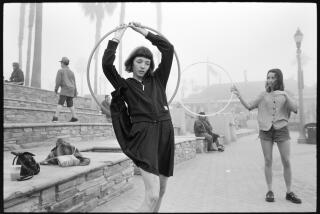Afghan street photographers fading away
- Share via
KABUL, AFGHANISTAN — Habibullah owns the last box camera still standing on Kabul’s Char-e-Sadart Street. It’s a classic: a battered, brightly painted box with a dusty lens at one end and a crude darkroom inside.
As recently as a year ago, Habibullah, 42, who uses one name, was one of hundreds of professional photographers who plied their trade with handmade box cameras, sort of slow-motion Polaroids using late 19th century technology. They stood sentinel on the busy downtown street, shooting mug shots of people who needed photos for paperwork at nearby government ministries.
But the digital camera has since conquered Kabul, killing off the traditional camera foree, or “fast instant cameras.” The clunky devices are sidelined as anachronisms, except for Habibullah’s gaudy red-and-blue model, which a few loyal customers still seek out for the moody, ethereal images it produces.
“They like their photos done the old way. For them, it’s nostalgia,” Habibullah said, wiping street grime from his camera as he waited for customers.
Reluctantly, Habibullah has bowed to technology. He has opened a tiny photo shop that features a Sony Cyber-shot digital camera and two printers. He still mans his post at the box camera outside, but he says 95% of his customers prefer the faster (and cheaper) photos from digital cameras.
A box camera photo sells for 40 afghanis, about 80 cents, and takes five to 10 minutes to shoot, develop and print. A set of four digital photos sells for about a dollar, and takes about five minutes to shoot and print.
Each camera is made from a wooden box with a 35-millimeter camera lens attached. Instead of clicking a shutter, the photographer removes the lens cap for a second and replaces it.
Inside the box is an entire darkroom -- paper, developer and fixer. After the latent image is exposed to a sheet of photo paper, the photographer inserts his hand into the box through a cut-off pants leg designed to keep out light that would ruin the print.
He develops the image by moving the paper through two trays, one holding developer and the other fixer, to create a paper negative. He then makes another exposure, which converts the negative image into a positive print.
The demise of the box cameras has been painful for men like Habib, a slender, energetic photographer who learned the trade from his father and uncle. Habib, 39, who uses one name, began taking street photos when he was 11. He took over his father’s camera and shot images for 28 years.
Desperate for work, Habib has taken up a job he dislikes, as an areza newsee, or scribe. He fills out government forms for illiterate Afghans, some of whom are former box camera clients.
He once earned as much as $80 a day with his camera, but now scratches out just $8 a day as a scribe.
Habib says he longs to return to the job he loves, if only he could persuade people that his black-and-white images are works of art compared with generic color shots from digital cameras.
“These are beautiful images,” he said, pointing to mug shots of stern-faced Afghans he has on one of the four cameras he built and still owns. “But people prefer the modern ones.”
Habib and several associates quit street photography late last year after security officials, in response to a car bombing, closed off the sidewalk outside the Interior Ministry, where they had set up their cameras. Other photographers went out of business after the sidewalks were dug up for a street-widening project.
At the same time, the cost of developer chemicals and photo paper rose, cementing the box cameras’ doom.
“It’s a very sad thing, because we are artists and we produce beautiful art,” Habib said. “Soon no one will know what we can do.”
A few years ago, Habib said, he was crowned the unofficial king of street photographers by a visiting New Zealand photographer who was impressed by his work. The man shot Habib’s photo beside his box camera and gave him a print labeled “champion.”
The New Zealander encouraged Habib to continue his profession, he said, saying his photos were superior to digital shots. The man paid $150 each for more than a dozen box cameras that Habib located through fellow photographers. At the time, he said, he counted 469 street cameras in downtown Kabul alone.
The photographer offered to set him up in a street photography business in New Zealand, Habib said. He said he gave his passport to the man’s Afghan interpreter, who promised to secure a visa. But he never saw either man again.
Habib still owns the gold-painted box camera he built as a gift for the New Zealander. He has faith that the man will return and fulfill his promises.
Although he said he has been offered $500 for the gold camera, he will keep it until he dies -- “and then they can bury it with me,” he said.
Habib still takes occasional family photos with his four box cameras and has also taught two of his sons to shoot and develop photos using them.
He has also taught them something else. It pains him to even say the words, and they slide from his mouth in a low whisper.
“I taught them,” he said, “to take digital photos too.”
--
More to Read
Sign up for Essential California
The most important California stories and recommendations in your inbox every morning.
You may occasionally receive promotional content from the Los Angeles Times.











